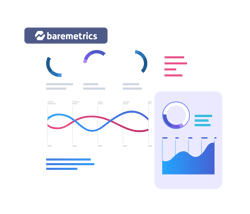Table of Contents

If you’re running a micro-SaaS business by yourself, chances are you haven’t had much time or budget to spend on marketing.
In fact, most founders focus resources almost exclusively on product development, and delay thinking about sales strategies until they desperately need their first customers. Of course, that’s already far too late to start running an effective ad campaign.
Without the support and expertise of dedicated staff, kicking off the marketing cycle may feel a little overwhelming. Where do you begin? Which platforms are worth exploring, and which are oversaturated money sinks? How do you elicit interest in your brand from your ICPs (Ideal Customer Profiles)?
Do those questions fill you with dread? You’re not alone.
The good news is, marketing strategies accessible to micro-SaaS founders absolutely do exist! These don’t rely on huge budgets and full-time attention – a little goes a long way, if you start early.
Here are 6 tips on how to build a successful ad campaign as a micro-SaaS business.
Tip 1: Start marketing now
The most common mistake first-time founders make is to wait too long before taking their business to market. Their products are often ready for distribution long before the developers themselves are. That perfectionism is losing their business money.
Delaying sales also slows growth exponentially. Any revenue a business makes early on can be pumped straight back into development.
Think of your first users as beta testers. Going to market early will allow you to receive ongoing feedback, which should be at the heart of all subsequent improvements.
Even if you release a mature product that you feel is perfect, development must be an iterative process that responds organically to what your ICPs want. And the only way to know whether your solution truly satisfied demand is to set it loose on the market.
A newly released product will never be perfectly market-adapted upon release, no matter how long it gestated. You might as well make some money on it sooner rather than later.
Furthermore, custom attracts custom: your first 10 users will help immeasurably in attracting your next 100. With some of that newly gained financial stability, you can start putting some of that revenue aside for your marketing budget, too.
If you’re unsure whether your SaaS has matured sufficiently to face the real world, here are 3 signs that your product is ready to go to market.
Tip 2: Opt for resource-efficient and long-lasting sales strategies
The more resources you allocate to marketing, the more people your campaign will reach.
That doesn’t mean that low-budget strategies can’t be incredibly effective, however; you simply need to be more deliberate with the types of campaigns you run.
Heavy-hitting messaging is the most powerful tool a low-budget campaign has at its disposal. Of all the marketing specialists in the world, the one role that is frequently overlooked in high profile ad campaigns is the creative.
If you’re stretching resources, you also need your marketing strategies to have a long life. Different campaign formats and platforms tend to have different life cycles. Many types of high profile campaigns tend to be effective only for a short amount of time, as viewers quickly grow tired of seeing the same ad over and over.
So what are some marketing strategies with the longest viable life spans?
For most SaaS businesses, content marketing and word-of-mouth marketing stays relevant, interesting, and ‘fresh’ for the longest, compared to other strategies.
Looking for further inspiration? Here are some alternative marketing strategies available to micro-SaaS founders.
Tip 3: Be specific about your marketing targets
Who you target is just as important as how you target them.
If you’ve just launched your SaaS product, you may not yet know who your good-fit users are. Ask yourself: who stands to benefit the most from your solution? Who has the resources available to invest in such a tool?
Once you have a broad target in mind, this guide on customer segmentation can help you narrow down your optimal user base, also known as your Ideal Customer Profiles.
These users are characterized by three traits: high MRR (monthly recurring revenue), high LTV (life-time value), and low maintenance in terms of the level of staff support they require.
Casting a wide net at first will help establish who your ICPs are. The sooner you can narrow down your targets, however, the more returns on your marketing efforts you’ll begin to see, especially in terms of quality of customer.
Tip 4: Use the pain points of your competitors in your ad copy
All’s fair in love and war… and SaaS sales.
Just kidding, we certainly don’t condone any questionable practices here.
That being said, a tried-and-true method of sales is to use the flaws of your competitors against them. There are 3 steps to this process:
- Find out what grievances your competitors’ users have with their services. One way to do this is by looking at negative reviews on their G2 or Capterra profiles.
- Refer to those pain points, and how your product solves those specific problems, in your ad copy
- Attract those users by offering better value (better product, better price point, better support)
This technique can be used in a variety of marketing channels, including paid SEO ads and content marketing. It can be subtle (listing features your competitors don’t have), or explicit (describing why you’re better than your main competitor, listed by name).
Research into your competition’s shortcomings will also reveal any untapped opportunities and current gaps in the market for development purposes.
The flipside of this coin is, of course, to listen to the pain points of your own users, and continually improve on your product. Otherwise, you’re giving your competitors a free shot at poaching your users in a never-ending game of Othello.
Tip 5 : Understand when to work manually vs. with automation
As a one-person business, relegating as many tasks as possible to automation tools may sound like a great way to reduce the never ending task-load.
There are many drawbacks to using automation, however.
Machine learning on Google, for instance, is unlocked at 30 conversations a month. For findings to be truly reliable, however, a minimum of 100 conversations per month is optimal. In other words, as a micro-SaaS with a low conversion rate, you’re better off relying on your own market research and observations for the time being.
Once you’ve run a couple of campaigns, you can start organizing strategies into portfolios to compare learnings from each cycle.
The benefit of a long-term, continuous marketing strategy (such as content marketing) over an episodic one (such as a television ad) is that it’s iterative. You can course correct at any point as you go.
If you do decide to use machine learning, this portfolio system will also allow you to feed in germaine elements from previous campaigns. A broader data set will yield more accurate and reliable results.
Manual outreach is powerful, but time consuming. We’re not suggesting you avoid automation tools altogether – just be strategic about when and how to apply them.
Appealing to prospects requires striking a balance between efficiency and personal touch. Luckily, there are great automation tools to help you with just that. Here is an overview of some of our favorite solutions.
As you’ll see in that article, some processes lend themselves very well to automation. These include data scraping, email validation, tracking unanswered emails, search alerts, to list but a few.
The key to automating outbound is to retain that ‘I’m talking to a human’ feel: a friendly tone, use of plain text, and a fast reply rate help enormously.
The kicker? The more personalized insights you glean about a prospect through the help of automation and machine learning, the more personal your approach will appear.
Tip 6 : Allocate your budget strategically
There are a few traps micro-SaaS businesses commonly fall into when it comes to creating a marketing budget.
The first mistake is to not have one. The ‘easy’ fix? Open a separate account and start directing money into it weekly without fail.
The second is to lump the entire marketing budget into a single heap.
This budget should be divided into 3 categories:
- Customer acquisition
- Brand awareness
- Research
These should be separated out for a few reasons.
Firstly, their purposes are entirely different, but all important nonetheless. Customer acquisition supports the business, brand reputation must be upheld so that prospects know and trust your product, and research brings to light new marketing opportunities in a quickly changing environment.
Secondly, these 3 aspects usually come into play at different points in the sales cycle. Failing to separate them out would skew both your market findings and your financial records.
Thirdly, your target ROI (return on investment) should be measured on different scales for each type of marketing. Neither research nor brand awareness tend to score better than a 2:1 ROI, whereas if the customer acquisition budget doesn’t produce 1:1 returns, the business could be in serious trouble.
Finally, there are certain marketing black holes to avoid entirely.
Big businesses may be able to afford premium LinkedIn accounts and bidding for competitive keywords, but as a micro-SaaS, you’d probably see better ROI throwing bills out of a high window.
Sometimes, knowing where not to spend your money is just as valuable.

![]()




